매년 이맘때쯤 할리우드는 가장 자아도취적인 기간, 바로 아카데미상 시상식에 이르는 기간에 접어든다. 업계 전문지 광고에 거대한 금액이 지출되며, LA와 뉴욕에서 런던까지 시사실 예약들이 꽉꽉 찬다. 이런 모든 대소동에 작은 사이드쇼가 되는 것은 최우수 외국어영화 부문이다. 아카데미상이 그저 지역 행사가 아니라는 것을 증명해 보이려는 할리우드의 상징적 시도다(사실 지역 행사지만, 이건 나중에 더 얘기하겠다). 아카데미 시상식이 생긴 지 20년 만인 1947년에서야 이 부문이 처음 도입됐다. 첫 수상작은 이탈리아 감독 비토리오 데 시카의 네오리얼리즘 걸작 <구두닦이>(Shoeshine Boys)였다.
그 이후로 가장 많이 수상한 나라는 이탈리아와 프랑스로, 각국이 오스카상 한 다스 정도씩 타갔으며, 부문은 거의 독점적으로 유럽영화에 의해 지배돼왔다. 아시아에서 가장 많이 수상한 나라는 일본으로, 1951년 구로사와 아키라 감독의 <라쇼몽>으로 시작했다. 그러나 일본이 수상한 오스카상 3개는 1951∼55년 4년간 동안 한꺼번에 다 탄 것이다. 45년이 지나서야- 반복하지만 ‘45년’- 아시아영화가 다시 부문상을 수상했다. 2000년, 리안 감독의 <와호장룡>이다.
대만 후보작을 표방했지만, <와호장룡>은 사실상 할리우드 기반의 콜럼비아픽처스가 홍콩지사를 통해 비중있게 투자한 것이다. 그리고 이 영화는 외국어영화치고 미국에서 흥행에 크게 성공한 편이었다. 이 두 가지 사실은 의미가 깊다.
요즘 외국어영화 부문상을 타려면 많은 돈 또는 많은 영향력이 있어야 하고, 강력한 미국 배급사는 거의 필수다. 대부분의 비용을 분담하기 위해서뿐만 아니라, 시스템(텔레비전, 인터뷰 등)을 할리우드 수준에서 활용하고 다루기 위해서다. 외국어영화는 수상으로 이익을 보는 일이 적다(이미 자국에선 개봉이 됐으니). 출품국가의 영화업계를 알리고, 영화를 만든 이들의 자존심을 세워주는 일 외에는 이득이 없다. 주로 이익을 받는 쪽은 미국 배급사다. 이런 모든 것에도 불구하고 매년 전 세계에 걸친 많은 국가들이 영화를 출품하면서 예술성이나 국내 흥행 성공이나 순수한 애국심으로 승자가 결정되리라 생각한다. 대체로 이런 것은 아카데미의 투표자들에게는 소용이 없다. 이들은 늙어가는 집단으로, 외국어영화 부문에서 유럽영화를 선호하는 경향이 있다. 유럽을 그림같이 그리며, 마음을 따뜻하게 하는 영화, 촬영이 잘된 영화- 사실, 유럽을 배경으로 한 할리우드영화와 상당히 비슷한 영화를 선호하는 것이다.
일부 업계 사람들은 이를 깨닫고 있다. 몇년 전 아시아영화 세일즈 대리인이자 프로듀서인 사람과의 대화가 생생히 기억난다. 그의 영화는 높은 평을 받는 예술영화로 그 부문에 출품됐다. 필자는 솔직히 그 작품이 후보에 오를 가망성이 없다고 말했고, 그 세일즈 대리인은 거기에 들어갈 돈을 생각하면서 한숨을 쉬고는 “나도 아는데 최선을 다해야 한다”고 했다. 애국심과 감독의 자존심을 챙겨주는 것은 돈이 많이 드는 일이다.
올해 출품된 49편의 목록 중에 한국 출품작 <태극기 휘날리며>(사진)만 어리석은 선택인 것은 아니다. 전쟁통의 남자들에 관한 영화가 외국어 영화 부문에 수상한 일은 전무하다.(보스니아 작품 <노 맨스 랜드>가 2001년 수상했지만 이는 같은 장르라 하기 어렵다.) 대신, 중국의 이국적인 <연인>이나 스페인의 훌륭한 <더 시 인사이드>(The Sea Inside)나 프랑스의 훈훈한 <레 코리스트>(Les choristes)가 2005년 1월25일 발표될 최종 5편의 후보작에 들어가는지를 살펴보라. 그런데, 어떻게 되든 누가 상관이나 하냐고.
At this time of year, Hollywood enters its most navel-gazing period - the run-up to the Academy Awards. Huge sums are spent on ads in trade papers, and screening rooms from Los Angeles and New York to London are booked solid.
A small sideshow to all this hoopla is the Best Foreign Film category - Hollywood's token attempt to prove that the Academy Awards are not just a local event. (They are - but more on that subject later.) It was only in 1947, 20 years after the Academy Awards were invented, that the category was first introduced. The first winner was Italian director Vittorio De Sica's neo-realist masterpiece "Shoeshine Boys."
Since then the biggest winners have been Italy and France, with about a dozen Oscars each, and the category has been almost exclusively dominated by European films. The biggest Asian winner is Japan, starting with Akira Kurosawa's "Rashomon" in 1951. But Japan won all three of its Oscars during a four-year period, 1951-55. It was to be another 45 years - repeat, 45 years - before an Asian film again won in the category: Ang Lee's "Crouching Tiger, Hidden Dragon" in 2000.
Though billed as representing Taiwan, "CTHD" was actually heavily financed by Hollywood-based Columbia Pictures, through its Hong Kong arm. And for a foreign-language movie, the film was also a huge box-office success in the US. Both facts are significant.
Nowadays, it takes a lot of money or a lot of influence to win the Foreign Film Oscar, and a powerful US distributor is virtually a requirement, not only for sharing the majority of the costs but also for working the system (TV, interviews) at a Hollywood level. Foreign films benefit little from winning (they've already been released locally), apart from raising the profile of a country's industry and massaging the egos of the filmmakers. The main beneficiary is the US distributor.
Despite all that, every year countries around the world submit their movies thinking that either artistry, local box-office success or sheer patriotism will win the day. Mostly, none of these count with the Academy's voters, an ageing group who, with the Foreign Film category, tend to favour movies from Europe that give a picturesque view of the region, are heartwarming, and nicely photographed - in fact, much like Hollywood films set in Europe.
Some industry people realize this. I vividly remember a conversation a few years ago with an Asian sales agent/producer whose film, a highly regarded art movie, had been submitted for the category. I frankly said it had no chance of even being nominated, and the sales agent sighed, thinking of the money about to be spent, and said, "I know, but I have to do my best." Patriotism and directors' egos are expensive things to service.
This year's South Korean entry, "Taegukgi," is not the only silly choice in the list of 49 foreign movies submitted. There are plenty of other local hits that don't stand the slightest chance of winning, and no movie about men in war has ever won the Foreign Film category. (The Bosnian production, "No Man's Land," which won in 2001, was hardly in the same genre.)
Instead, look for titles like China's exotic "House of Flying Daggers," Spain's deeply worthy "The Sea Inside" and France's heartwarming "Les choristes" to make the final five nominations announced on January 25. And who really cares anyway?


